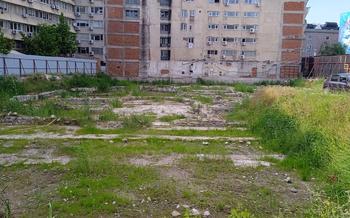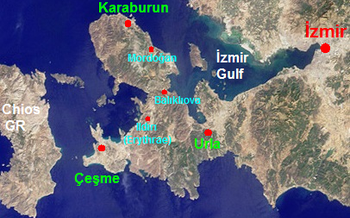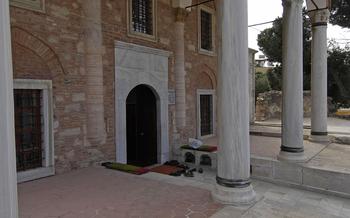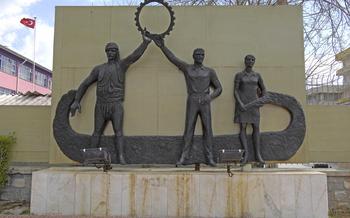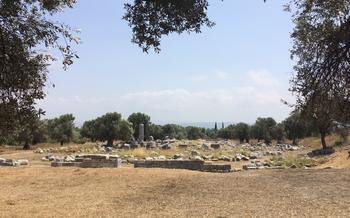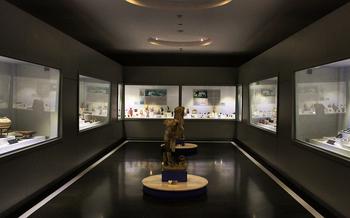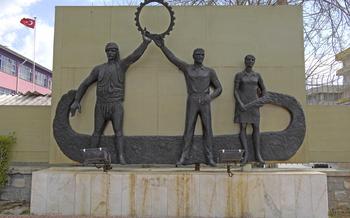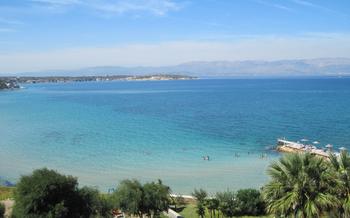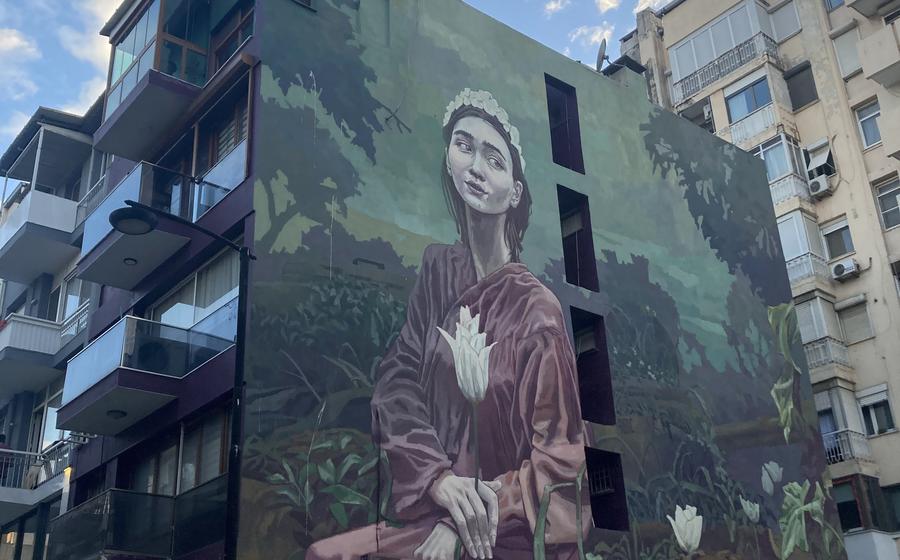
Lebedos Ancient City
- Lebedos Ancient City: A Journey Through Time
- Unveiling the Ruins of Lebedos
- Exploring the Necropolis
- Lebedos Museum: A Treasure Trove of Artifacts
- Immerse Yourself in the Local Culture
- Plan Your Visit: Essential Tips
- Best time to visit Lebedos
- Recommended duration for exploring the site
- Essential packing list for a comfortable visit
- Guided tours and self-guided exploration options
- Capture the Essence of Lebedos
- Discover the Enchanting Surroundings
- Unraveling the Mysteries of Lebedos
- Connect with the Past: Historical Reenactments
- Lebedos in Literature and Art
- Beyond the Ruins: Lebedos in Context
Lebedos Ancient City: A Journey Through Time
Lebedos, an ancient Ionian city located on the western coast of Turkey, offers a captivating journey into the past. Its rich history dates back to the 11th century BCE, making it one of the earliest settlements in the region. Lebedos flourished as a maritime and commercial hub, serving as a vital link between the Aegean Sea and the Anatolian hinterland. Its strategic location at the mouth of the Gediz River provided access to fertile agricultural lands, contributing to its prosperity.
The city's significance is further enhanced by its association with notable figures from antiquity. According to legend, Lebedos was the birthplace of the philosopher Anaximenes, a prominent pre-Socratic thinker. The city also played a role in the Ionian Revolt against Persian rule in the 6th century BCE, demonstrating its independent spirit and resistance to foreign domination.
In the Roman period, Lebedos became part of the Roman province of Asia and continued to thrive as a regional center. Archaeological excavations conducted in the 20th century have uncovered impressive remains of the ancient city, shedding light on its urban layout, public buildings, and daily life. The ruins of Lebedos stand as a testament to its enduring legacy, inviting visitors to explore the depths of its history and immerse themselves in the atmosphere of a bygone era.
The ancient city of Lebedos is situated in the modern-day Urla district of İzmir province, approximately 35 kilometers west of the city of İzmir. Its coastal location provides stunning views of the Aegean Sea, adding to the allure of this historical site. Lebedos is easily accessible by road, with well-maintained highways connecting it to major cities and towns in the region. Visitors can conveniently drive or take public transportation to reach the ancient city, making it a popular destination for history enthusiasts and travelers seeking a glimpse into Turkey's rich cultural heritage.
Unveiling the Ruins of Lebedos
Ascending from the sandy beaches, visitors to Lebedos are greeted by the imposing sight of the city walls, a testament to the city's resilience and grandeur. These fortifications, once an impenetrable barrier, now stand partially eroded, revealing glimpses of the vibrant life that once flowed within. The gates, strategically positioned along the walls, served as portals to the bustling streets of Lebedos, welcoming traders, travelers, and pilgrims alike.
Venturing into the heart of the ancient city, one encounters the agora, the focal point of civic and commercial life. Here, merchants displayed their wares, philosophers engaged in lively debates, and citizens gathered to discuss matters of governance. Public buildings, such as the bouleuterion (council chamber) and the prytaneion (government building), lined the agora, their impressive facades echoing the city's administrative power.
A short stroll from the agora leads to the theater, a majestic structure carved into the hillside. Its tiers of stone seats could once accommodate thousands of spectators, who gathered to witness theatrical performances, musical concerts, and civic events. The odeon, a smaller theater nearby, served as a venue for more intimate performances and recitals.
Religious devotion played a central role in Lebedos' society, as evidenced by the numerous temples and religious structures scattered throughout the city. The Temple of Apollo, dedicated to the sun god, stands as the most prominent of these sacred sites. Its colossal columns and intricate carvings hint at the grandeur of Lebedos' religious practices. Other temples, dedicated to deities such as Zeus, Athena, and Artemis, reflect the diverse religious beliefs of the city's inhabitants.
Exploring the Necropolis
The necropolis of Lebedos lies just outside the city walls, offering a glimpse into the burial practices and beliefs of its ancient inhabitants. Arranged in a sprawling complex, the tombs vary in size and design, from simple pit graves to elaborate chamber tombs.
Some of the most notable tombs include the Tomb of the Lion, featuring a majestic lion sculpture guarding the entrance, and the Tomb of the Musicians, adorned with intricate carvings depicting musical instruments and scenes of musicians performing. These tombs provide insights into the social status and wealth of the deceased, as well as the importance of music and art in Lebedos' society.
The necropolis also reveals the diverse burial customs practiced in Lebedos. While cremation was common, inhumation was also practiced, with bodies laid to rest in stone sarcophagi or ceramic vessels. Grave goods, such as pottery, jewelry, and personal items, were often placed alongside the deceased to accompany them into the afterlife.
These burial practices and the elaborate tombs suggest that the people of Lebedos believed in an afterlife, where the deceased would continue to exist in some form. The necropolis, therefore, serves as a poignant reminder of the deep-rooted spiritual beliefs and rituals that shaped the lives of Lebedos' ancient inhabitants.
Lebedos Museum: A Treasure Trove of Artifacts
The Lebedos Museum, situated in the heart of the ancient city, is a treasure trove of artifacts unearthed from the archaeological excavations conducted at the site. This remarkable museum houses a diverse collection of artifacts that provide valuable insights into the daily life and culture of Lebedos' inhabitants.
Upon entering the museum, visitors are greeted by an array of pottery vessels, ranging from humble household items to intricately decorated vases. These ceramic masterpieces showcase the artistic prowess and craftsmanship of the Lebedos people. Among the most notable exhibits is a collection of terracotta figurines depicting gods, goddesses, and mythical creatures, offering a glimpse into the religious beliefs and mythology of ancient Lebedos.
The museum also features an impressive collection of coins minted in Lebedos, bearing the city's emblem and various motifs. These coins not only served as a medium of exchange but also provide valuable historical information, shedding light on the city's economy and trade relations.
Furthermore, the museum showcases a captivating array of jewelry, including intricate gold and silver necklaces, earrings, and bracelets. These adornments demonstrate the craftsmanship and artistry of the Lebedos people, as well as their love of beauty and personal ornamentation.
The Lebedos Museum is not merely a repository of artifacts but also a testament to the rich cultural heritage of this ancient city. Through its carefully curated exhibits, the museum offers visitors a unique opportunity to delve into the past and gain a deeper understanding of the lives and traditions of the people who once called Lebedos home.
Immerse Yourself in the Local Culture
Lebedos offers a vibrant cultural scene that invites visitors to delve into the region's rich traditions and heritage. Gastronomes will delight in the local cuisine, which blends fresh, seasonal ingredients with unique flavors. Sample traditional dishes like "Alaçatı Otlu Peyniri," a savory cheese pie made with wild greens, or "Çeşme Kumrusu," a toasted sandwich filled with cheese, sausage, and tomato.
Explore the charming streets of the nearby town of Alaçatı, known for its vibrant art and handicraft scene. Discover unique souvenirs inspired by Lebedos' ancient past, such as hand-painted pottery, woven textiles, and intricate jewelry. Immerse yourself in the lively festivals and events that celebrate Lebedos' heritage, such as the annual Lebedos Festival, which showcases traditional music, dance, and local crafts.
Embrace the opportunity for cultural exchange with the friendly locals, who are passionate about sharing their stories and traditions. Engage in conversations, learn about their daily lives, and gain insights into the modern-day significance of Lebedos. Embrace the warmth and hospitality of the region as you immerse yourself in the local culture and create lasting memories.
Plan Your Visit: Essential Tips
Best time to visit Lebedos
The best time to visit Lebedos is during the shoulder seasons, spring (April-May) and autumn (September-October), when the weather is mild and pleasant for outdoor exploration. Summer months (June-August) can be hot and crowded, while winters (November-March) are generally cold and wet.
Recommended duration for exploring the site
A half-day is sufficient to explore the main highlights of Lebedos, including the city walls, agora, theater, and necropolis. However, if you want to delve deeper into the history and immerse yourself in the atmosphere, plan for a full day or even an overnight stay in the nearby town of Urla.
Essential packing list for a comfortable visit
To make your visit to Lebedos as comfortable as possible, consider packing the following essentials:
- Comfortable walking shoes or hiking boots for exploring the uneven terrain.
- A hat, sunscreen, and sunglasses to protect yourself from the sun.
- Water and snacks, as there are no food or beverage options within the ancient city.
- A camera to capture the stunning views and historical artifacts.
- A flashlight or headlamp if you plan to explore the necropolis or visit the museum at night.
Guided tours and self-guided exploration options
Guided tours of Lebedos are available from local tour operators in Urla. These tours typically provide insights into the history and significance of the ancient city and are a good option for those who want to learn more about the site. If you prefer to explore at your own pace, you can opt for self-guided exploration using maps, guidebooks, or mobile apps.
Capture the Essence of Lebedos
Lebedos offers a multitude of opportunities for photography enthusiasts to capture the essence of this ancient city. With its well-preserved ruins, stunning natural surroundings, and vibrant local culture, Lebedos is a visual feast waiting to be explored.
Tips for Photography Enthusiasts:
-
Prepare Your Gear: Lebedos is a large site, so consider bringing a comfortable camera bag to carry your gear. A wide-angle lens is useful for capturing the expansive views, while a telephoto lens can help you zoom in on specific details.
-
Golden Hours: The golden hours, just after sunrise and just before sunset, offer the most dramatic lighting conditions for photography. Plan your visit accordingly to witness Lebedos bathed in the warm glow of the golden light.
-
Explore Different Perspectives: Don't just stick to the main paths. Explore the lesser-visited corners of the site to discover hidden gems and unique perspectives. Experiment with different angles and compositions to create dynamic and captivating images.
-
Photograph People: Lebedos is not just about ruins; it's also about the people who live and work here. Capture portraits of locals, visitors, or even reenactors to add a human element to your photographs.
Recommended Spots for Panoramic Views:
-
Acropolis: Climb to the top of the acropolis for breathtaking panoramic views of the entire site, the surrounding countryside, and the sparkling Aegean Sea in the distance.
-
Theater: The theater offers another elevated vantage point with stunning views of the stage, the surrounding hills, and the ancient city beyond.
-
Necropolis: The necropolis, located on a hilltop, provides a unique perspective of the ancient city, with the ruins of the theater, agora, and temples framed by the rugged landscape.
Sharing Your Lebedos Experiences:
Share your Lebedos photographs with the world and help promote this hidden gem to fellow travelers and history enthusiasts. Use social media platforms, travel blogs, or online photography communities to showcase your work and inspire others to visit this remarkable ancient city.
Discover the Enchanting Surroundings
Beyond the ancient ruins of Lebedos, the region offers a plethora of captivating attractions. The nearby village of Çandarlı, with its charming cobblestone streets and traditional Ottoman-era houses, invites you to delve into the local culture. Explore the bustling bazaar, savor the flavors of regional cuisine at authentic restaurants, and soak up the lively atmosphere of this vibrant village.
Venture further afield to uncover natural wonders and landscapes of unparalleled beauty. Mount Sipylus, an awe-inspiring natural monument, beckons with its majestic peaks and verdant slopes. Embark on invigorating hikes through its scenic trails, marvel at the fascinating rock formations, and capture breathtaking panoramas of the surrounding countryside.
For a refreshing immersion in nature, head to the Dalyan Beach, a pristine haven with crystal-clear waters and golden sands. Indulge in sun-soaked relaxation, swim amidst the gentle waves, and enjoy leisurely strolls along the picturesque coastline.
Enhance your Lebedos experience with captivating day trips and excursions. Explore the nearby ancient city of Ephesus, a UNESCO World Heritage Site, and marvel at its remarkably preserved ruins, including the iconic Library of Celsus. Discover the Cave of Zeus, nestled in the scenic Dilek Peninsula National Park, and immerse yourself in its fascinating mythology and natural beauty.
Combine your Lebedos exploration with other captivating destinations in Turkey. Izmir, the vibrant provincial capital, offers a harmonious blend of history, culture, and modern amenities. Explore its bustling bazaars, savor delectable seafood dishes, and admire the stunning views from Kadifekale, the historic citadel.
Venturing further afield, embark on a journey to Cappadocia, a land of surreal landscapes, fascinating rock formations, and unique cave dwellings. Witness the mesmerizing hot air balloon rides at sunrise, explore the underground cities, and immerse yourself in the region's rich history and culture.
Whether you seek cultural immersion, natural wonders, or historical exploration, the surroundings of Lebedos offer a wealth of experiences to enrich your journey through this ancient city.
Unraveling the Mysteries of Lebedos
Ongoing archaeological research and discoveries at Lebedos continue to shed light on the city's rich history and significance. Excavations have revealed fascinating artifacts, structures, and inscriptions that provide valuable insights into the daily life, culture, and beliefs of the ancient inhabitants. Archaeologists are working tirelessly to uncover new secrets, piece together the puzzle of Lebedos' past, and reconstruct the story of this remarkable ancient city.
Conservation efforts play a crucial role in preserving the ruins of Lebedos for future generations. The Turkish government, in collaboration with international organizations, has implemented comprehensive conservation and restoration projects to protect the ancient city from the ravages of time and natural elements. These efforts include structural reinforcement, restoration of damaged buildings, and the implementation of sustainable tourism practices to minimize the impact of visitors on the site.
Lebedos faces several challenges in its preservation. One significant challenge is the need to balance the demands of tourism and the preservation of the ancient city. While tourism brings economic benefits and raises awareness of Lebedos' cultural heritage, it also poses risks to the integrity of the ruins. Managing the flow of visitors, implementing strict regulations, and educating tourists about responsible behavior are essential to ensure the sustainable preservation of Lebedos.
Despite these challenges, the future of Lebedos as a cultural heritage site is bright. With ongoing research, conservation efforts, and increasing recognition of its historical significance, Lebedos is poised to become a major attraction for history enthusiasts, archaeologists, and travelers from around the world. The ancient city stands as a testament to the enduring legacy of the past, inviting visitors to explore its mysteries and discover the stories that its ruins hold.
Connect with the Past: Historical Reenactments
Lebedos comes alive during historical reenactments, offering visitors a unique chance to step back in time and experience the city's rich past firsthand. These events transport you to a bygone era, allowing you to witness ancient rituals, witness traditional performances, and interact with characters dressed in authentic costumes.
Participate in hands-on activities, learn about ancient crafts, and immerse yourself in the daily life of Lebedos' inhabitants. Whether you're dressing in traditional attire, trying your hand at ancient skills, or simply observing the reenactments, you'll gain a deeper appreciation for the city's history and culture.
Lebedos in Literature and Art
Lebedos has served as a rich source of inspiration for literary and artistic creations throughout history. Its allure and mystique have captured the imaginations of writers, poets, painters, and sculptors, who have immortalized the ancient city in their works.
In literature, Lebedos has been featured in novels, short stories, and poems, where it serves as a backdrop for historical tales, love stories, and explorations of mythology. The city's ruins, its natural beauty, and its rich history have provided a fertile ground for literary creativity.
Artistic representations of Lebedos can be found in various forms, including paintings, sculptures, and mosaics. These artworks often depict the city's iconic landmarks, such as the theater, the temple of Apollo, and the agora. They offer a glimpse into the architectural grandeur and artistic achievements of Lebedos in its heyday.
The influence of Lebedos on modern-day art and literature can be seen in the works of contemporary artists and writers who draw inspiration from the ancient city's history and legacy. Through their creative expressions, they help to keep the memory of Lebedos alive and relevant for future generations.
Exploring the cultural significance of Lebedos through artistic expressions provides a unique and immersive way to connect with the past and appreciate the enduring legacy of this ancient city.
Beyond the Ruins: Lebedos in Context
Lebedos played a pivotal role in the ancient world, serving as a bustling hub for trade and commerce. Its strategic location on the Aegean coast facilitated the exchange of goods and ideas with other Greek city-states and civilizations across the Mediterranean.
As a thriving port city, Lebedos was a melting pot of cultures, where diverse influences converged. Greek, Persian, and Ionian elements intertwined, shaping the city's unique identity. This cultural amalgamation is reflected in the architecture, art, and religious practices unearthed at the site.
Understanding Lebedos' significance extends beyond its physical remains. The city's enduring legacy lies in its contributions to the broader historical narrative. Lebedos was an integral part of the Ionian League, a powerful alliance of Greek city-states.
Moreover, it played a role in the Peloponnesian War, a pivotal conflict that shaped the course of ancient Greece. By exploring Lebedos, we gain a deeper appreciation for the interconnectedness of the ancient world and the complexities of its political, economic, and cultural dynamics.
